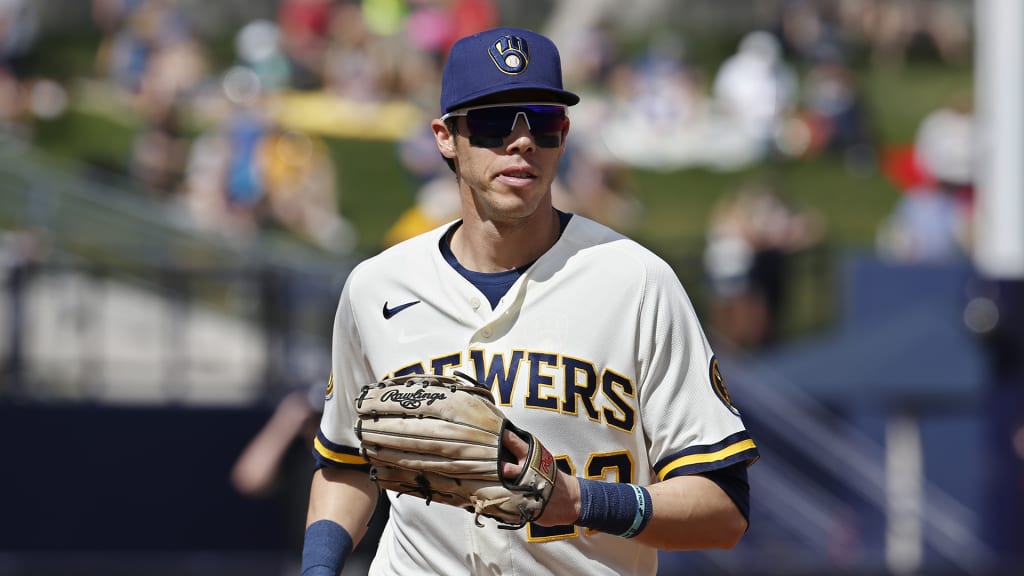
MILWAUKEE -- Before baseball was paused indefinitely due to the coronavirus pandemic, there was Brock Holt's arrival, Christian Yelich's commitment, lots of pitchers working on sliders and a slew of other developments at American Family Fields of Phoenix.
Here is a look back at three things we learned in Spring Training, and what they might mean when baseball resumes:
It’s on to Part 3 of acquire, develop, retain.
For a long time, the narrative was that the Brewers’ best and most popular players usually got away, from Paul Molitor and Greg Vaughn to CC Sabathia and Prince Fielder. Yelich, however, opted to stay put after agreeing to a new, nine-year contract that guaranteed $215 million through 2028, and includes a mutual option for a 10th season in 2029. For both sides, there’s risk. From the club’s point of view, it’s a record commitment, and only the third contract in franchise history in excess of $50 million. For Yelich, he gave up the right to shop his services to 29 other teams in three years. But for Brewers fans, it was a cause to celebrate. And for president of baseball operations David Stearns, who also inked 23-year-old Freddy Peralta to a five-year deal, it marked a foray into the third phase of the “acquire, develop, retain” mantra he espoused after taking the Brewers’ helm in 2015.
“This is a place where I wanted to play and where I wanted to be,” Yelich said. “I realize that I had three years before free agency, but above all else, I meant it when I said that I want to finish my career as a Milwaukee Brewer.”
Expect many moving pieces.
Fans of the 1982 Brewers can still go around the diamond and name the starting position players: Ted Simmons, Cecil Cooper, Jim Gantner, Paul Molitor, Robin Yount, Ben Oglivie, Gorman Thomas and Charlie Moore. Moore moved around some but the others essentially ran out to the same position every day. That’s how good teams were built back then. Now, the Brewers were planning a different approach to their reconfigured position player group, one that resembled the “strength in numbers” approach Stearns and Craig Counsell have applied to pitching in recent years. The plan called for one or two “everyday” players -- left fielder Yelich and second baseman Keston Hiura, presumably -- and then many players, including some of the 15 Major Leaguers acquired by Stearns during a busy winter, combining to man the other positions. Omar Narváez and Manny Piña at catcher. Justin Smoak and Ryan Braun at first base. Orlando Arcia and Luis Urías at shortstop. Jedd Gyorko and Eric Sogard at third base. Lorenzo Cain and Avisaíl García in center field. García and Braun in right field. Holt all over.
“We have to figure out how to get their strengths on the field, at the best times for them,” Counsell said. “There’s a lot of that in this group. I do see a lot of players getting a pretty good number of at-bats, and only maybe one or two players getting to a really high number. That’s how it’s shaping it up to be. That means we’re sharing a lot of it; almost similar to how the pitching has looked. If there’s a comparison there, that’s it.”
Their depth was already being tested.
The Brewers came to Spring Training confident that they were built to withstand the injuries sure to impact a team over the course of a 162-game season. That concept was already being tested. Urías spent February and the start of March recovering from surgery for a fractured hamate bone in his left hand, and while he was poised to debut in the Cactus League just as games were suspended, it was unclear whether he would have time to make it a real competition for shortstop with Arcia. On the pitching side, Eric Lauer’s left shoulder impingement meant that Peralta was poised to begin the season in the starting rotation, and that Corbin Burnes -- a camp standout -- would be on the Opening Day roster in some fashion. A delay of at least eight weeks before Opening Day means that barring a setback in informal workouts, those particular injuries should be healed by the time play resumes. Ditto for former All-Star closer Corey Knebel, who was looking at an early May return from Tommy John surgery. So, everything we thought we know about how the pieces would fit together is outdated, pending more information about when baseball will be back.
“Operationally, this is something we’ve never experienced before,” Stearns said on a conference call with reporters on Sunday. “There are a whole host of concerns that we are working through right now. First on that list of concerns is making sure that all of our employees are safe, and that includes our players, that includes our coaches, it includes our medical staff, our front office staff, our part-time workers and temporary workers. We have 300 employees, and we have to make sure we are providing all of them a safe environment in which to work. So that’s been the top-level concern.
“Beyond that, we obviously operationally have Major League Baseball players and Minor League Baseball players that at some point are going to begin a season. So, we have to work through how to make sure that whenever that occurs, they are appropriately prepared.”
